1.4 Configurations Supported by Sun Cluster
A cluster is composed of a set of physical hosts, or nodes. Throughout the Sun Cluster documentation, cluster nodes also are referred to as Sun Cluster servers.
The Sun Cluster hardware configuration supports symmetric, asymmetric, clustered pairs, ring, N+1 (star), or N to N (scalable) topologies. Each of these is described in detail later in this chapter.
A symmetric configuration has only two nodes. Both servers are configured identically and, generally, both provide data services during normal operation. See Figure 1-12.
A two-node configuration where one server operates as the hot-standby server for the other is referred to as an asymmetric configuration. This configuration is treated as an N+1 configuration where N=1.
Clustered pairs are two pairs of Sun Cluster nodes operating under a single cluster administrative framework. See Figure 1-13.
The ring configuration allows for one primary and one backup server to be specified for each set of data services. All disk storage is dual-hosted and physically attached to exactly two cluster nodes. The nodes and storage are connected alternately, in a ring. This is ideal for configuring multiple online highly available data services. See Figure 1-14.
An N+1 or star configuration is composed of two or more nodes. One node in the N+1 configuration (the +1 node) might be configured to be inactive until there is a failure of another node. In this configuration, the +1 node operates as a "hot-standby." The remaining nodes are "active" in normal operation. The examples in this chapter assume that the hot-standby node is not running data services in normal operation. However there is no requirement that the +1 node not run data services in normal operation. See Figure 1-15.
An N to N, or scalable configuration has all servers directly connected to a set of shared disks. This is the most flexible configuration because data services can fail over to any of the other servers. See Figure 1-16.
1.4.1 High Availability and Parallel Database Configurations
Sun Cluster supports HA data service and parallel database configurations. HA and parallel databases can also be combined within a single cluster, with some restrictions.
Data services in an HA configuration are made highly available by having multiple hosts connected to the same physical disk enclosure. The status of each host is monitored over private interconnects. If one of the hosts fails, another host connected to the same shared storage device can take over the data service work previously done by the failed host. Figure 1-10 shows an example of a highly available data service configuration.
Figure 1-10 Highly Available Data Services Configuration

Oracle Parallel Server (OPS) enables a relational database to be highly available by enabling multiple hosts to access the same data on shared storage devices. Traffic to the shared disk enclosures is controlled by a DLM that prevents two processes from accessing the same data at the same time. High availability is attained by redirecting database access traffic from a failed host to one of the remaining nodes. Figure 1-11 shows an example of a highly available OPS configuration. The private interconnect can be either the Scalable Coherent Interface (SCI) or Fast Ethernet.
Figure 1-11 OPS Database Configuration
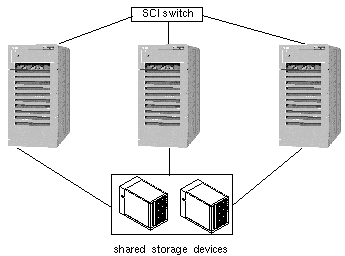
The Informix-Online XPS parallel database permits parallel access by partitioning the relational database across shared storage devices. Multiple host processes can access the same database simultaneously provided they do not access data stored in the same partition. Access to a particular partition is through a single host, so if that host fails, no access is possible to that partition of data. For this reason, Informix-Online XPS is a parallel database, but cannot be configured to be highly available in a Sun Cluster.
1.4.2 Symmetric and Asymmetric Configurations
Symmetric and asymmetric HA configuration, by definition, consists of exactly two nodes. Highly available data services run on one or both nodes. Figure 1-12 shows a two-node configuration. This example configuration consists of two active nodes (phys-hahost1 and phys-hahost2) that are referred to as siblings.
Both nodes are physically connected to a set of multihost disks.
Figure 1-12 Two-node Configuration
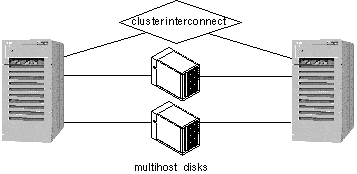
1.4.3 Clustered Pairs Configuration
The clustered pairs configuration is a variation on the symmetric configuration. In this configuration, there are two pairs of servers, with each pair operating independently. However, all of the servers are connected by the private interconnects and are under control of the Sun Cluster software.
Figure 1-13 Clustered Pairs Configuration
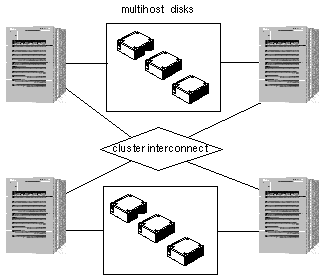
Clustered pairs can be configured so that you can run a parallel database application on one pair and HA data services on the other. Failover is only possible across a pair.
1.4.4 Ring Configuration
The ring configuration allows for one primary and one backup server to be specified for each set of data services. The backup for a given data service is a node adjacent to the primary. All disk storage is dual-hosted and physically attached to exactly two cluster nodes. The nodes and storage are connected alternately, in a ring. All nodes can be actively running applications. Each node is both a primary for one set of data services and a backup for another set. Figure 1-14 shows a four-node ring configuration.
Figure 1-14 Ring Configuration
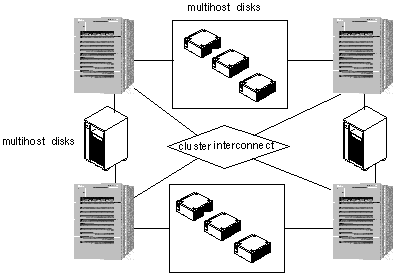
Note -
A restriction to the ring configuration is that you cannot run multiple RDBMS data services on the same node.
1.4.5 N+1 Configuration (Star)
An N+1 or star configuration includes some number of active servers and one hot-standby server. The active servers and hot-standby server do not have to be configured identically. Figure 1-15 shows an N+1 configuration. The active servers provide on-going data services while the hot-standby server waits for one or more of the active servers to fail. The hot-standby server is the only server in the configuration that has physical disk connections to all disk expansion units.
In the event of a failure of one active server, the data services from the failed server fail over to the hot-standby server. The hot-standby server then continues to provide data services until the data services are switched over manually to the original active server.
The hot-standby server need not be idle while waiting for another Sun Cluster server to fail. However, the hot-standby server should always have enough excess CPU capacity to handle the load should one of the active servers fail.
Figure 1-15 N+1 Configuration
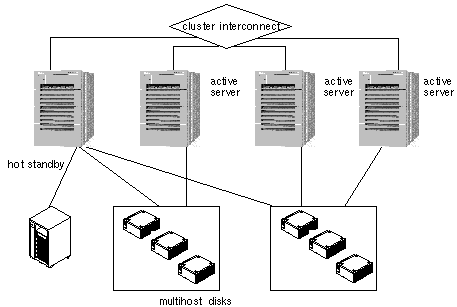
1.4.6 N to N Configuration (Scalable)
An N to N or scalable configuration has all servers physically connected to all multihost disks. Data services can fail over from one node to a backup, to another backup, a feature known as cascading failover.
This is the highest redundancy configuration because data services can fail over to up to three other nodes.
Figure 1-16 N to N Configuration

1.4.7 Campus Clustering
Sun Cluster features campus clustering, a cluster configuration that provides geographic site separation and enables recovery from certain types of failures, which is localized to a part of the campus.
The servers and storage devices may be physically located in the same server room, or geographically distributed across multiple sites. Geographical distribution improves protection of data from catastrophic failures, such as a fire, and thus improves overall data service availability.
For additional information on campus clustering, contact your local Sun sales representative.
- © 2010, Oracle Corporation and/or its affiliates
